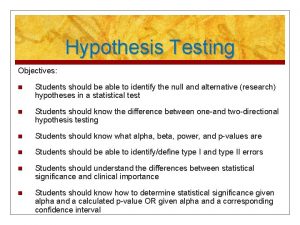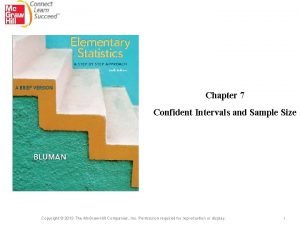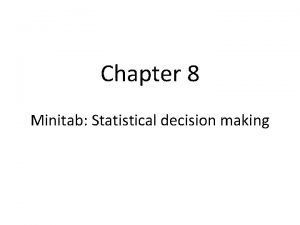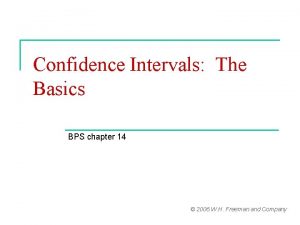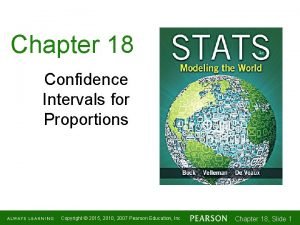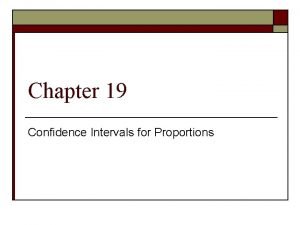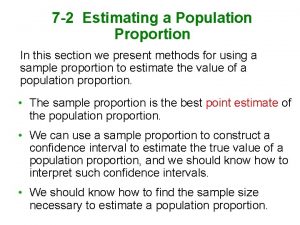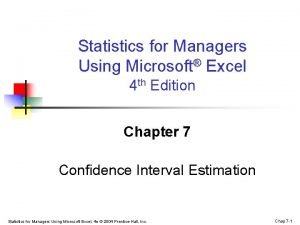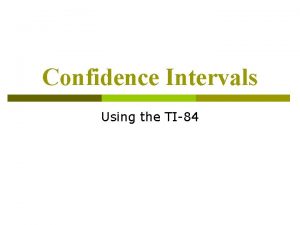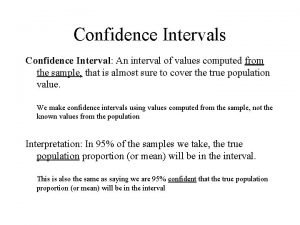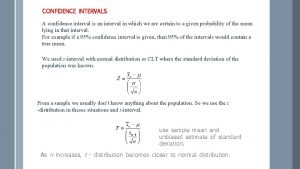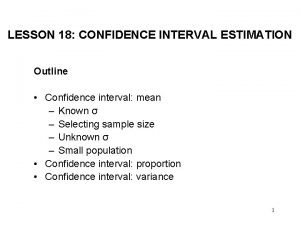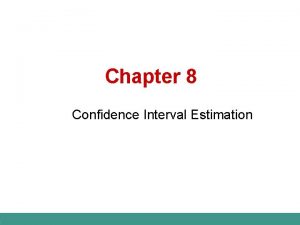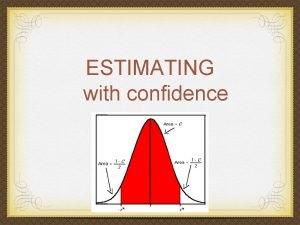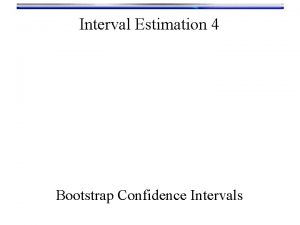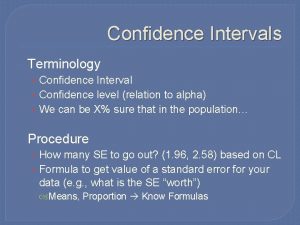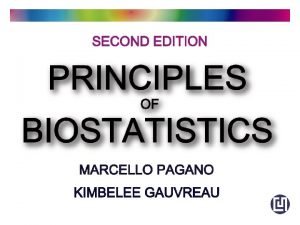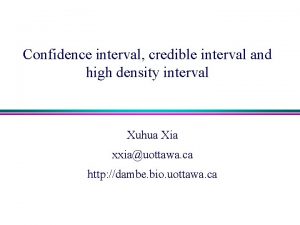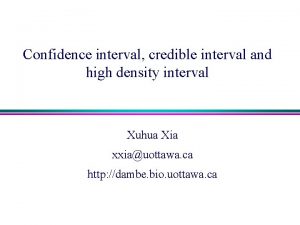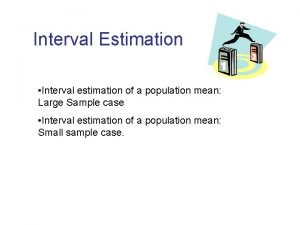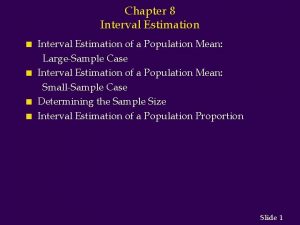Interval Estimation 2 Computing Confidence Intervals Confidence Intervals














- Slides: 14

Interval Estimation 2 Computing Confidence Intervals

Confidence Intervals • So how do we compute a (1 − a)× 100% confidence interval given a set of data? ? • Conceptually, if we are trying to estimate a parameter q with some estimator we have to know something about the sampling distribution of the estimator • For large IID samples, one can show that is approximately normal: Approx. sampling dist. of an estimator (large IID sample assumed)

Confidence Intervals • To explicitly take sample size, n, into account (and thus be more conservative), instead use the student-T distribution: Approx. sampling dist. of an estimator (IID sample of size n) We will use the Student-T assumption for the sampling distribution by default

Intuition: Student-t vs Normal Sampling Dists Student-t distribution Fatter in the tails Normal distribution

Intuition: Student-t and tc Student-t PDF, d. f. = 3 Area = 0. 99 0. 95 5. 84 -3. 18 for (two-sided) 99% 95% confidence tc = 5. 84 3. 18

Confidence Intervals • Construction of a CI for a mean depends on: • • Sample size n Mean estimate Estimated standard error for the mean Level of confidence 1 -α • α is significance level • Use α to compute tc-value • (1 -α)× 100% CI for population mean using a sample average and standard error is:

Example: Confidence Intervals • Compute a 99% two sided confidence interval for the RI of a glass shard using this sample set: Fragment # Fragment n. D 1 1. 52005 2 1. 52003 3 1. 52001 4 1. 52004 5 1. 52000 6 1. 52001 7 1. 52008 8 1. 52011 9 1. 52008 10 1. 52008 11 1. 52008 ?

Example: Confidence Intervals # Data x <- c(1. 52005, 1. 52003, 1. 52001, 1. 52004, 1. 52000, 1. 52001, 1. 52008, 1. 52011, 1. 52008, 1. 52008) n <- length(x) # Estimate of parameter: mu. hat <- mean(x) # Standard deviation of the data sdx. hat <- sd(x) # Standard error of the mean estimate se. hat <- sd(x)/sqrt(n) # Compute tc for given sample size and chosen confidence level conf <- 0. 99 alpha <- 1 -conf tc <- qt(1 - alpha/2, df = n-1) # Put the CI mu. hat. lo <mu. hat. hi <c(mu. hat. lo, together: mu. hat - tc*se. hat mu. hat + tc*se. hat mu. hat. hi)

Example: Confidence Intervals Approx. Sampling Distribution for Mean 1. 520017 99% Confidence 1. 520087

Example: Confidence Intervals • Compute a 99% two sided confidence interval for the RI of a glass shard using this sample set: Fragment # Fragment n. D 1 1. 52005 2 1. 52003 3 1. 52001 4 1. 52004 5 1. 52000 6 1. 52001 Putting this together: 7 1. 52008 [1. 520052 - (3. 17)(0. 00001), 1. 520052 + (3. 17)(0. 00001)] 8 1. 52011 9 1. 52008 99% CI for sample = [1. 520017, 1. 520087] 10 1. 52008 11 1. 52008

Another Exercise A suspect, one Mr. B. Mayhew is captured by law enforcement officials in possession of many mini-Ziploc baggies containing what is determined to be very pure, dry methamphetamine. The forensic lab’s analytical balances are reliable to 4 -decimal places. The baggies are emptied and collected into one mass of crystals. 10 mass measurements are taken (units g): 49. 9996, 49. 9994, 49. 9993, 49. 9996, 49. 9995, 49. 9994 a. Compute the one-sided 95% CI for the lower bound on the mean mass b. Compute the one-sided 95% CI for the upper bound on the mean mass c. Sketch pictures of where these CIs would appear on the approximate sampling distribution for the meth’s mass

# Data for Mr. Mayhew's seizure: x <- c(49. 9996, 49. 9994, 49. 9993, 49. 9996, 49. 9995, 49. 9994) n <- length(x) # a. **One-sided lower bound. The assumed "upper limit" is Infinity # Estimate of mean: mu. hat <- mean(x) # Estimate of the standard deviation of the data sdx. hat <- sd(x) # Standard error of the mean estimate se. hat <- sd(x)/sqrt(n) # Compute tc for given sample size conf <- 0. 95 alpha <- 1 -conf tc <- qt(1 - alpha, df = n-1) # # and chosen confidence level **This is the big change. Now we don't split the alpha between the tails. For the lower bound we put all the alpha on the lower tail. Therefore -tc! # Put the One-sided lower bound CI together: mu. hat. lo <- mu. hat - tc*se. hat c(mu. hat. lo, Inf) # b. **One-sided upper bound. The assumed "lower limit" is -Infinity # Everything is the same except now we put all the alpha in the upper tail. mu. hat. hi <- mu. hat + tc*se. hat c(-Inf, mu. hat. hi)

Another Exercise

Another Exercise 49. 99952 95% Confidence One sided, upper bound 49. 99942 95% Confidence One sided, lower bound
 Confidence interval vs confidence level
Confidence interval vs confidence level Critical value for z score
Critical value for z score How to interpret confidence intervals example
How to interpret confidence intervals example Confidence interval for variance
Confidence interval for variance Confidence interval excel
Confidence interval excel Confidence intervals minitab
Confidence intervals minitab Reporting confidence intervals
Reporting confidence intervals Chapter 18 confidence intervals for proportions
Chapter 18 confidence intervals for proportions Chapter 19 confidence intervals for proportions
Chapter 19 confidence intervals for proportions Is ap stat hard
Is ap stat hard Common critical values
Common critical values How to add 95 confidence intervals in excel
How to add 95 confidence intervals in excel Critical value for 90 confidence interval
Critical value for 90 confidence interval How to do confidence intervals on ti 84
How to do confidence intervals on ti 84 Secondary reinforcer
Secondary reinforcer
